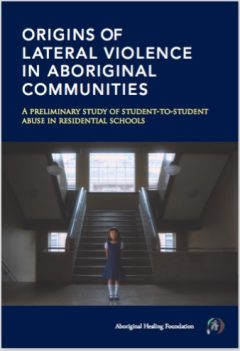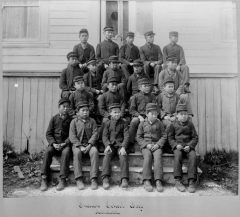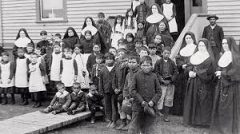Understanding the broad impacts of Indian Residential Schools (IRSs) on survivors, their families, and communities is integral to the healing and reconciliation process. Initiated by the Aboriginal Healing Foundation, we were involved in exploring how the IRSs contributed to the lateral violence evident in many Indigenous communities in Canada. This research is shared through several resources:
 Bombay, A., Matheson, K., & Anisman, H. (2014). Origins of lateral violence in Aboriginal communities: A preliminary study of student-to-student abuse in residential schools. Aboriginal Healing Foundation, Ottawa, ON.
Bombay, A., Matheson, K., & Anisman, H. (2014). Origins of lateral violence in Aboriginal communities: A preliminary study of student-to-student abuse in residential schools. Aboriginal Healing Foundation, Ottawa, ON.
This book provides a broad descriptive overview of the pervasiveness of student-to-student abuse that was facilitated and encouraged in Indian Residential Schools based on interviews with service providers working with survivors of the IRSs.
 Matheson, K., Bombay, A., Haslam, S.A. & Anisman, H. (2016). Indigenous identity transformations: The pivotal role of student-to-student abuse in Indian Residential Schools. Transcultural Psychiatry, 53(5), 551–573.
Matheson, K., Bombay, A., Haslam, S.A. & Anisman, H. (2016). Indigenous identity transformations: The pivotal role of student-to-student abuse in Indian Residential Schools. Transcultural Psychiatry, 53(5), 551–573.
In this article, we adopt a social identity theory approach to provide insights into how student-to-student abuse evolves in the IRSs and its insidious effects on relationships among survivors who experienced such abuse.
 Kimberly Matheson and Amy Bombay discuss their article, ‘Indigenous identity transformations: The pivotal role of student-to-student abuse in Indian Residential Schools’ in a podcast was posted on December 8, 2016 on Sage Psychology & Psychiatry. It can be downloaded here.
Kimberly Matheson and Amy Bombay discuss their article, ‘Indigenous identity transformations: The pivotal role of student-to-student abuse in Indian Residential Schools’ in a podcast was posted on December 8, 2016 on Sage Psychology & Psychiatry. It can be downloaded here.